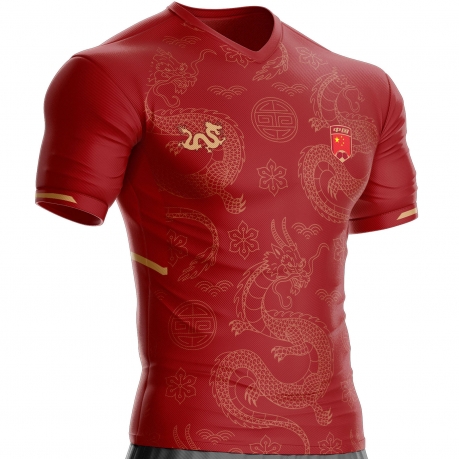The history of Chinese football

The History of Chinese Football: A Journey Through Dynasties and Eras
Football is the most popular sport in China today, with millions of fans and players of all ages. But what is the history of this sport in this vast and ancient country? Where does this passion that drives the crowds come from ?
In fact, Chinese football has a long and rich history dating back centuries before modern football appeared in Europe. It has its roots in an ancient game called "cuju", played since the time of the Han dynasty (250 BC). J.-C. - 220 AD. J.-C.).
Cuju was a rudimentary but fascinating ball game, involving two teams competing on a rectangular field. The goal was to propel the ball into the opponent's goal using the feet and head, without using the hands. This game was very popular with the Chinese, and it was played by both the military and civilians for entertainment and training.
Cuju has evolved over the centuries, and its rules and equipment have been refined. Over time, it influenced other ball games in other parts of the world, contributing to the birth of modern football as we know it today.
As Western football took off in Europe in the 19th century, it also found its way to China. The first modern football matches were organized by European expatriates in major Chinese cities in the late 19th and early 20th centuries.
It was not until the beginning of the 20th century that football began to gain popularity among the Chinese population. The establishment of the Chinese Football Federation in 1924 marked an important turning point in the development of sport in the country.
The history of Chinese football is a fascinating story that reflects the evolution of Chinese society itself. From the ancient origins of cuju to the rise of modern football, including the challenges and successes of the national team, Chinese football has come a long way and continues to develop today.
In the next sections of this article, we will explore in detail the different stages of Chinese football history, analyzing its key moments, challenges and ambitions for the future.
The Cuju: The precursor of football (2500 BC). J.-C. - 17th century)
Cuju, ancestor of Chinese football, has its origins as early as 2500 BC. J.-C. under the dynasty of Xia.exclamation This rudimentary ball game, played by soldiers and civilians, was both entertainment and training physique.exclamation
Cuju rules:
Cuju was played on a rectangular field, often divided into two parts by a central line. Two teams of seven to fifteen players competed against each other, the objective being to propel a leather ball filled with feathers or animal hair into the opposing goal.
The rules of cuju were quite simple:
-
It was forbidden to use hands to touch the balle.expand_more
-
Only the feet, head and chest were allowed for diriger.exclamation
-
Players could tackle the opponent to take the ball.
Cuju equipment:
The cuju's equipment was rudimentary:
-
The ball was usually made of leather and filled with feathers or animal hair.animaux.expand_more
-
Players wore loose, comfortable clothing to facilitate mouvements.exclamation
-
Leather protections were sometimes used for the legs and arms.
Cuju in Chinese society:
Cuju was a very popular game in society chinoise.expand_more It was practiced by all social classes, from emperors to paysans.expand_more
-
Cuju was considered a great way to develop strength, agility and teamwork.
-
It was also used as entertainment during festivals and ceremonials.monies.expand_more
-
Cuju was even practiced by women, which was quite rare for the time.poque.expand_more
The evolution of cuju over time:
Cuju has evolved over the centuries. The rules and equipment were refined, and the game became more complex and technical.
-
During the Han dynasty (250 BC). J.-C. - 220 AD. J.-C.), cuju experienced a boom important.exclamationMore precise rules were established and the game became an official sport in military games.
-
During subsequent dynasties, cuju continued to develop and diversify. New variations of the game have been created, with different rules and equipment.
-
Cuju reached its peak during the Ming Dynasty (1368-1644).exclamation The game was then played by millions of people throughout the country and was considered a sport national.exclamation
Comparison between cuju and modern football:
Cuju and modern football share many similarities:
-
Two teams compete on a rectangular field.
-
The objective is to score goals by propelling the ball into the goal adverse.expand_more
-
Players cannot use hands to touch the ball.
However, there are also important differences:
-
Cuju was played with a ball smaller and lighter than a football moderne.exclamation
-
The number of players on the field was variable in cuju, while it is fixed in modern football.
-
The tackles were rougher in the cuju and there was no hors-jeu.exclamation
Cuju played an important role in the development of football moderne.expand_more He contributed to the diffusion of the game and the development of its rules and its standard.quipement.exclamation
Cuju is an important heritage of Chinese culture. He helped shape football history and inspire the sport we know and love today.
The arrival of Western football and its beginnings in China (19th - early 20th century)
Modern football first appeared in China in the 19th century, thanks to European traders and missionaries. The latter introduced the sport to large coastal cities such as Shanghai, Guangzhou and Tianjin, where they organized matches among themselves.
The first football matches in China:
The first football matches in China were quite rudimentary. The rules were not always well defined and the equipment was often improvised.
-
Matches were usually held on vacant lots or in parks.
-
Players wore street clothes and used makeshift balls.
-
The audience was often made up of curious people and European expatriates.
Slow adoption of football by the Chinese population:
At first, football was considered a foreign and barbaric sport by the Chinese population. It took time for the sport to gain popularity and adapt to Chinese culture.
-
Some Chinese intellectuals criticized football as too violent and frivolous.
-
The lack of infrastructure and equipment made playing football difficult for most Chinese.
Creation of the first Chinese football federation:
Despite these obstacles, football has gradually gained popularity among young Chinese people. In 1924, the first Chinese football federation was established. This creation marked an important turning point in the development of Chinese football.
FIFA Affiliation:
In 1931, the Chinese Football Federation was affiliated with FIFA, the world football body. This affiliation allowed China to participate in international competitions and compete with the best teams in the world.
The arrival of Western football in China was a slow and difficult process. But thanks to the perseverance of Chinese football pioneers, the sport eventually took hold and became a national passion.
Slow development and troubled period (early 20th - 1990s)
The development of professional football in China has been relatively slow compared to Europe and South America. This can be explained by several factors:
Economic factors:
-
China was a poor and developing country in the early 20th century.
-
The lack of investment and infrastructure made playing professional football difficult.
-
Football was not considered a priority by the Chinese government.
Political factors:
-
China experienced a period of political unrest and civil wars during the 20th century.
-
These events had a negative impact on the development of the sport.
-
The Chinese government has sometimes used football as a political propaganda tool.
Cultural factors:
-
Football was not a sporting tradition in China.
-
Chinese audiences were more attracted to traditional sports like kung fu and tai chi.
-
The lack of training and supervision has also slowed the development of professional football.
Chinese national team performances:
Despite these obstacles, the Chinese national team enjoyed some success during this period.
-
In 1936, China participated in the Berlin Olympics.
-
In 1957, China won the Asian Nations Cup.
-
In 1982, China participated in its first World Cup.
However, these successes were rare and the Chinese national team failed to qualify for the World Cup after 1982.
The development of professional football in China was slow and difficult during the 20th century. But despite the obstacles, the sport continued to gain popularity and grow. The next section of this article will examine the rise of Chinese football in the 1990s and 2000s.
The rise of Chinese football: professionalization and ambition (1990s to today)
Chinese football has experienced significant growth since the 1990s. This growth is marked by several key events:
Creation of the Chinese professional league in 1994:
The creation of the Chinese professional league in 1994 was a major turning point in the development of Chinese football. This league allowed the best Chinese players to professionalize and make a living from their sport.
Impact on football popularity:
The creation of the professional league had a positive impact on the popularity of football in China. The Chinese public was attracted by the spectacle of professional matches and the exploits of Chinese players.
Increased investments:
The rise of Chinese football has also attracted investors. Chinese and foreign companies have invested in football clubs, improving infrastructure and recruiting talented foreign players.
Infrastructure modernization:
Many stadiums have been built or renovated in China in recent years. These modern infrastructures make it possible to host football matches in optimal conditions.
Arrival of foreign players:
The arrival of foreign players has contributed to improving the level of play in Chinese football. These players brought their experience and know-how to Chinese clubs.
Recent performances of the Chinese national team:
The Chinese national team has seen encouraging results in recent years.
-
In 2002, China participated in its second World Cup.
-
In 2015, China won the Asian Nations Cup for the second time.
-
The Chinese national team is currently in the running for qualification for the 2026 World Cup.
Ambitions for the future:
Chinese football has great ambitions for the future. The Chinese Football Association aims to make China a leading football nation.
-
The goal is to regularly qualify the Chinese national team for the World Cup.
-
China also wants to host the FIFA World Cup in the future.
Chinese football has experienced spectacular development in recent years. The professionalization of sport, increased investment and modernization of infrastructure have contributed to the improvement of the level of play and the popularization of football in China. The Chinese national team has big ambitions for the future and aims to become a leading football nation.
Challenges:
Despite the progress made, Chinese football still faces certain challenges:
-
Corruption is a significant problem in Chinese football.
-
The level of play of Chinese clubs is still far from the best European and South American clubs.
-
The development of women's football in China lags behind men's football.
Chinese football has great development potential. With continued investment and good management, Chinese football can become a major force on the international stage.
The challenges of Chinese football
Despite the progress made in recent years, Chinese football still faces several challenges:
Corruption:
Corruption is a significant problem in Chinese football. Cases of match-fixing and suspicious transfers have been regularly reported in recent years. The Chinese Football Association has taken steps to combat corruption, but the problem remains persistent.
Infrastructure development:
Infrastructure development is another important challenge for Chinese football. Many Chinese stadiums are still dilapidated and do not meet international standards. The construction of new stadiums and the renovation of existing infrastructure are necessary to improve the level of play and attract the best players in the world.
Training of young players:
The training of young players is a crucial area for the development of Chinese football. The country needs to put in place an effective training system to identify and develop talents from an early age.
Fan fervor and violence:
The fervor of Chinese fans is an important asset for Chinese football. However, it can sometimes turn into violence. Incidents of violence between fans have been reported during some matches. The Chinese Football Association must take measures to prevent violence and ensure the safety of fans.
Chinese football has great development potential. With continued investment, good management and solutions to the challenges that hold it back, Chinese football can become a major force on the international stage.
Other challenges:
-
The lack of fair play and respect for the rules by certain players and coaches.
-
The lack of professionalism in club management.
-
The low level of Chinese arbitration.
Chinese football is booming, but there is still a long way to go to achieve the ambitious goals set by the Chinese Football Association. With strong political will and effective management, Chinese football can become a true global power.
The history of Chinese football is long and rich, dating back to the ancient game of cuju played as early as 2500 BC. J.-C. After the introduction of modern football in the 19th century, the sport experienced slow and difficult development due to various economic, political and cultural factors.
However, since the 1990s, Chinese football has experienced significant growth thanks to professionalization, increased investment and modernization of infrastructure. The Chinese national team has seen encouraging results in recent years and aims to become a leading football nation.
Development potential:
Chinese football has great development potential. The country has a huge population and a booming economy. The Chinese government is also committed to developing football and making China a leading football nation.
Future of Chinese football:
I am optimistic about the future of Chinese football. With continued investment, good management and solutions to the challenges that hold it back, Chinese football can become a major force on the international stage.
Place on the international scene:
I believe Chinese football has the potential to become one of the best football nations in the world. The country has all the ingredients necessary for success: a passionate population, a determined government and significant resources.
Key takeaways:
-
Chinese football has a long and rich history.
-
Chinese football has experienced significant growth in recent years.
-
Chinese football has great development potential.
-
I am optimistic about the future of Chinese football.
-
Chinese football has the potential to become one of the best football nations in the world.






